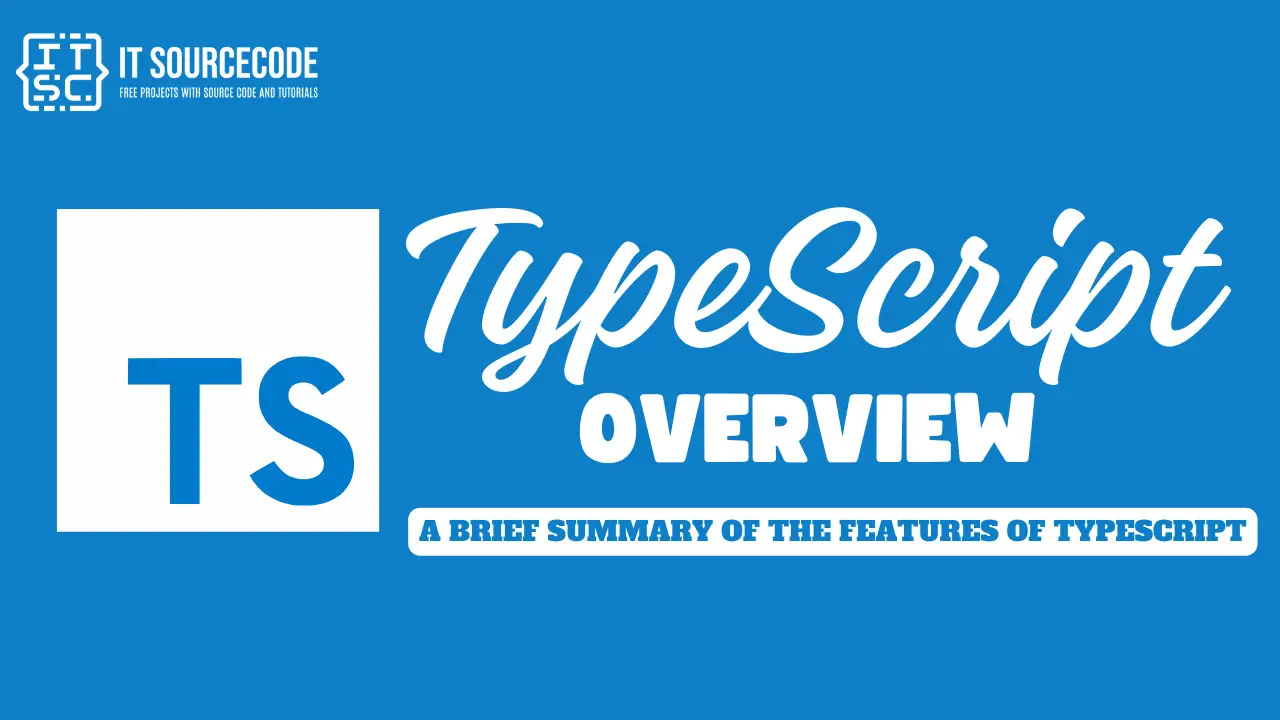What is TypeScript?
Typescript is a high-level programming language that is both free and open-source and was created by Microsoft.
In addition to that, TypeScript is a superset of JavaScript, which simply means any valid JavaScript code is also valid code in TypeScript.
However, TypeScript introduces optional static typing and other features, making it a powerful tool for building large-scale applications.
For example:
function greet(name: string) {
return `Welcome to, ${name}!`;
}
let message = greet("Itsourcecode");
console.log(message);Output:
Welcome to Itsourcecode!TypeScript Version History
The following table provides you with the list of TypeScript Version History.
| Version | Released Date |
|---|---|
| TypeScript 0.8 | October 2012 |
| TypeScript 0.9 | June 2013 |
| TypeScript 1.0 | October 2014 |
| TypeScript 2.0 | September 2016 |
| TypeScript 3.0 | July 2018 |
| TypeScript 4.0 | August 2020 |
| TypeScript 4.4 | 2021 |
| TypeScript 5.4.5 | The latest version |
Components of TypeScript
TypeScript is made up of three main components:
1. Language
This is the actual TypeScript code you write. This includes syntax, keywords, and type annotations.
2. Compiler
This changes your TypeScript code into JavaScript.
3. Language Services
This part gives information that helps tools like editors offer better features such as automated refactoring and IntelliSense. This helps with things like auto-completion in your code editor.
How to use TypeScript?
You write TypeScript code in a file that ends with .ts. Then you use the TypeScript compiler to change it into JavaScript.
You can write TypeScript in any code editor. You need to install the TypeScript compiler first.
After it’s installed, you use the command tsc .ts to change your TypeScript code into JavaScript. You can then put the JavaScript in your HTML and it will run in any web browser.
TypeScript Features
Here are the features of TypeScript:
- Static Typing:
TypeScript verifies your code for errors before it runs.
- Code Completion:
TypeScript helps you write code faster with suggestions.
- Incremental Adoption:
You can start using TypeScript bit by bit in your project.
- Library Integration:
TypeScript works well with JavaScript libraries and frameworks
- Cross-Platform:
TypeScript works wherever JavaScript does. You can install the TypeScript compiler on any operating system like Windows, macOS, or Linux.
- Object-Oriented Language:
TypeScript has strong features like Classes, Interfaces, and Modules. You can use it to write object-oriented code for both client-side and server-side.
- Static type-checking:
TypeScript checks your code for errors as you type it by using type annotations. It also guesses the type of a variable if you don’t declare it.
- Optional Static Typing:
If you like JavaScript’s dynamic typing, you can use that in TypeScript too.
- DOM Manipulation:
TypeScript can change the DOM just like JavaScript.
- ES 6 Features:
TypeScript Advantages
Here are the advantages of TypeScript.
- Easy Typing
TypeScript lets you add types to your code, which can make it easier to understand.
- Catch Mistakes Early
TypeScript helps find mistakes in your code before you run it.
- Clear Code:
TypeScript’s types make your code easier to read.
- Helpful Tools:
TypeScript works well with code editors, giving you hints and help as you code.
- Quick Changes:
TypeScript makes it easy to change lots of code at once.
- Object-Oriented:
TypeScript lets you use object-oriented programming, like classes.
- Works Everywhere:
You can run TypeScript code in any browser.
- Lots of Developers:
Many JavaScript developers can also use TypeScript.
- Big Tech Support:
Big companies like Microsoft and Google use TypeScript.
- Typescript includes most of the features
TypeScript includes most of the features planned for future versions of JavaScript like ES 6 and 7. This includes things like classes, interfaces, and arrow functions.
- TypeScript is just JavaScript.
It starts and ends with JavaScript, and uses the same basic parts. So if you know JavaScript, you can use TypeScript. All TypeScript code is changed into JavaScript to run it.
- TypeScript works with other JavaScript libraries.
Once TypeScript is changed into JavaScript, it can be used with any JavaScript code. It can also use all the existing JavaScript tools and libraries.
- JavaScript is TypeScript.
This means you can change any .js file to a .ts file and it will work with TypeScript.
TypeScript can be used anywhere. It works on all browsers, devices, and operating systems. It can run wherever JavaScript runs. Unlike some other languages, TypeScript doesn’t need a special machine or environment to run.
Why we should use TypeScript?
Here are some reasons why you might want to use TypeScript:
- TypeScript is a statically typed language, which means you define the type of a variable when you declare it. This can help catch errors at compile time rather than runtime, making your code more reliable and easier to debug.
- TypeScript provides better autocompletion, navigation, and refactoring services, making the development process smoother and more efficient.
- TypeScript supports new and future JavaScript features, allowing you to write modern JavaScript while ensuring it will be compatible with older environments.
- TypeScript has full support for interfaces and classes, making it a good choice for large-scale applications or projects that require strong object-oriented programming (OOP) capabilities.
- TypeScript’s static typing and OOP features can make the code more readable and easier to maintain, especially in large codebases.
Conclusion
There you have it, we’re done exploring the TypeScript Overview: A Brief Summary of the Features of TypeScript.
TypeScript, a statically typed superset of JavaScript, offers a robust set of features that enhance the JavaScript development experience.
Its static typing and object-oriented programming capabilities contribute to the reliability, efficiency, and maintainability of code. Its rich feature set makes it a compelling choice for modern web development.
I hope that by understanding the TypeScript Overview, you can now start to create your own project in TypeScript.
If you have any questions or inquiries, please don’t hesitate to leave a comment below.

